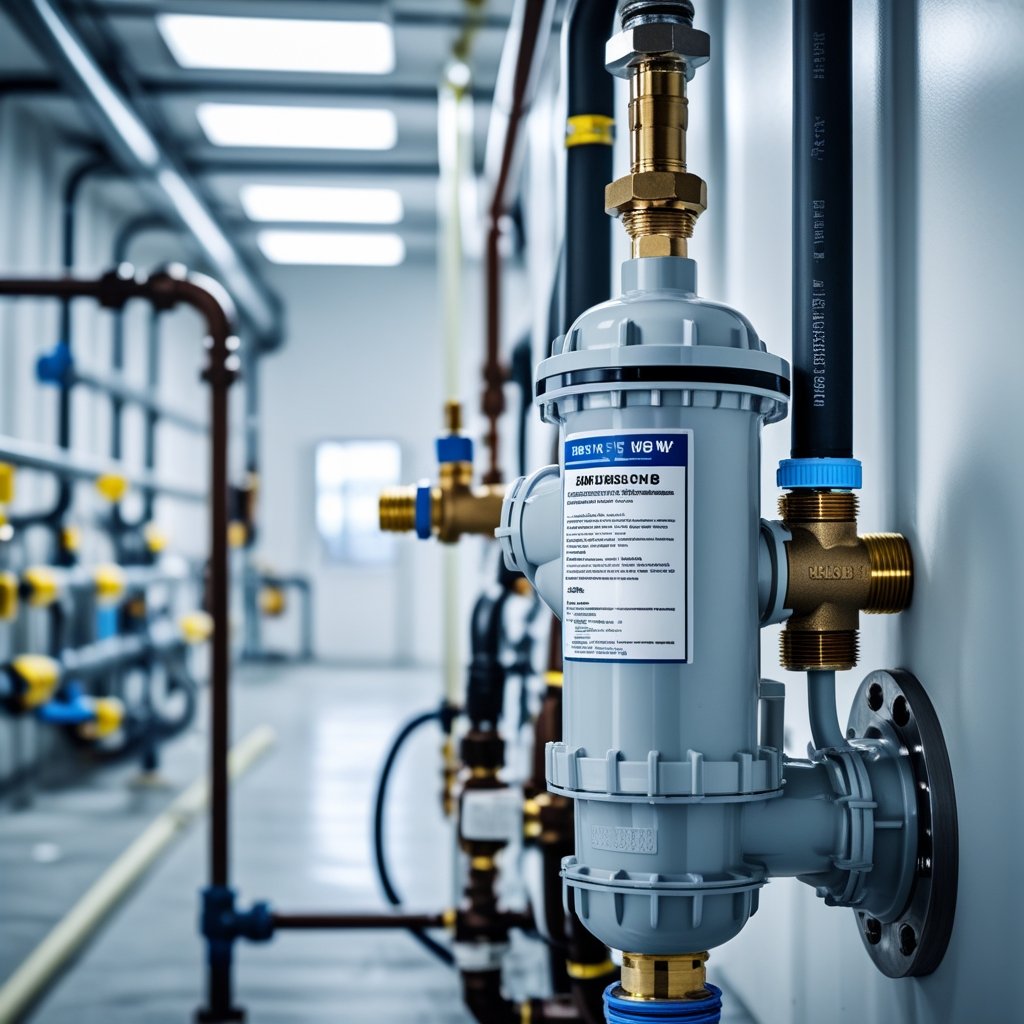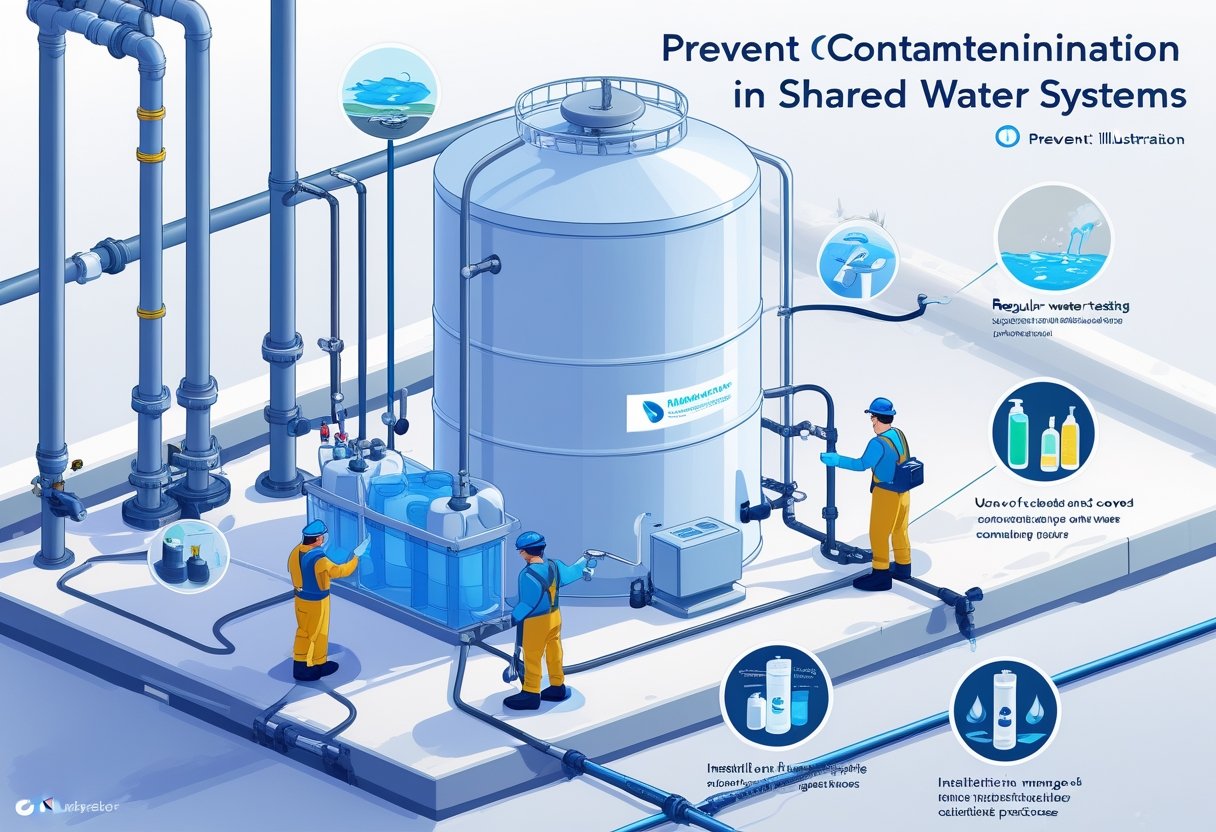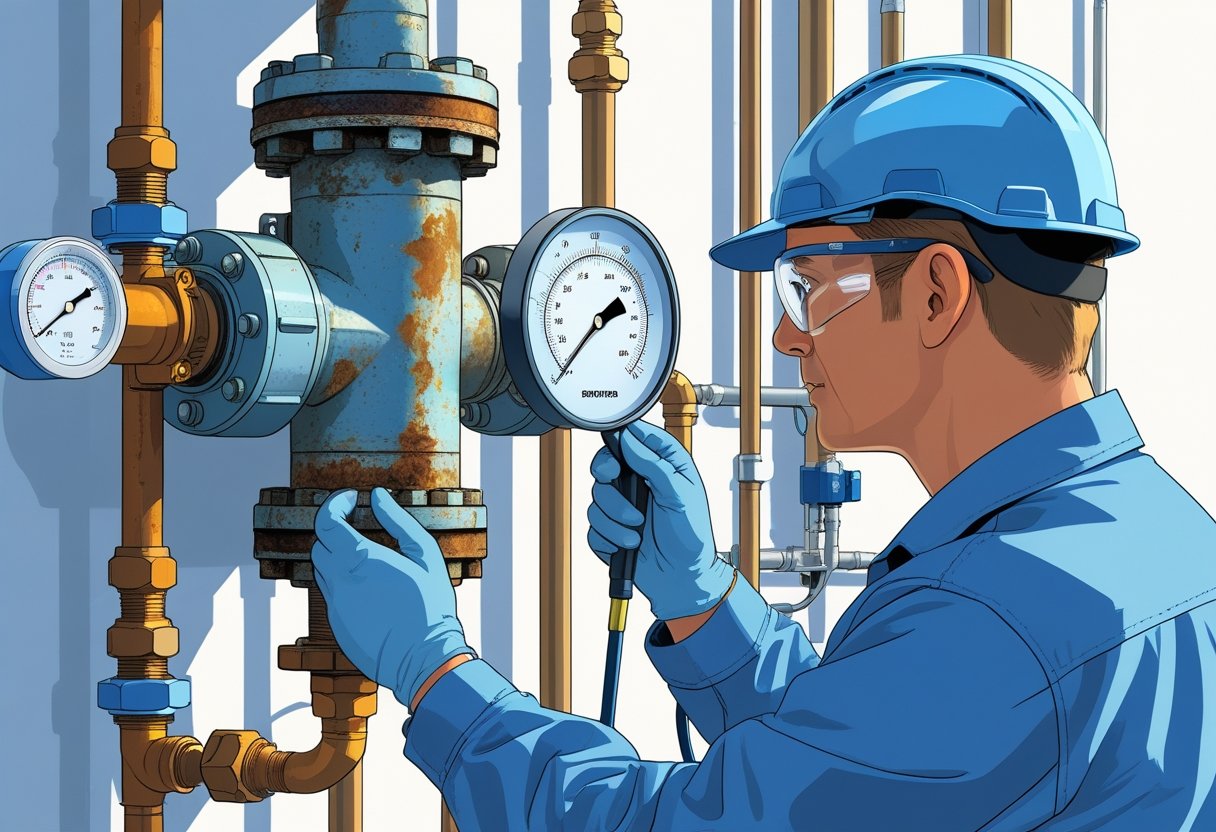Keeping your backflow device in good shape matters for protecting your water supply and making sure your plumbing system does its job. Regular care helps prevent leaks, blockages, and contamination, keeping your water safe for you and your community. Neglecting maintenance? That’s just asking for device failure or expensive repairs.
You don’t need to be a plumbing whiz to keep your backflow preventer running. Simple things—like testing, cleaning, and checking for wear—can go a long way. Whether you’re dealing with a sprinkler system or something more commercial, a little effort keeps headaches at bay.
At Pacific Backflow, we see firsthand how important these devices are across San Diego County. With a bit of routine care, you’ll dodge emergencies and stay on the right side of local regulations. Let’s walk through some practical tips to keep your backflow device safe and working.
Understanding Backflow Devices
Backflow devices keep your water safe by stopping dirty or contaminated water from sneaking back into your clean supply. They come in a few varieties, each with its own way of protecting your home or business. Knowing the basics helps you keep up with maintenance and local rules.
What Is a Backflow Device?
A backflow device is basically a one-way gate for your plumbing. It keeps water moving in the right direction, which matters because if water reverses, it can drag along chemicals, bacteria, or waste into your clean system.
You’ll spot backflow devices on homes, businesses, or irrigation systems—anywhere water lines hook up to public or private supplies. Their main job? Stopping contaminated water from mixing with drinking water, especially when water pressure fluctuates.
Testing, repairing, and maintaining your backflow preventer regularly keeps your water clean and safe.
Types of Backflow Prevention Devices
Here are a few common types you might run into:
- Reduced Pressure Zone (RPZ) Device: Super effective. Uses a special valve system to block backflow in both low and high hazard spots.
- Double Check Valve Assembly (DCVA): Two spring-loaded check valves keep water from reversing. Good for lower-risk areas.
- Atmospheric Vacuum Breaker (AVB): You’ll often find this on irrigation systems. It prevents back siphonage but needs to sit above the water outlet.
- Pressure Vacuum Breaker (PVB): Like the AVB, but it works even if it’s installed below the outlet since it relies on pressure.
Picking the right device depends on your setup and local codes. If you’re unsure, a certified pro from Pacific Backflow can help you figure it out.
How Backflow Devices Work
Backflow devices use valves or air gaps to control water direction. If water tries to move backward, the device shuts it down.
Take an RPZ device: if supply-side pressure drops, the valve closes so dirty water can’t sneak back. Check valve setups close automatically if water reverses.
Some devices use air gaps—a literal space that stops water from flowing the wrong way, especially outdoors.
Testing makes sure these parts are doing their job. If your device fails a test, you’ll need repairs or maybe a replacement to keep your water safe and meet code.
Importance of Backflow Device Maintenance
Keeping your backflow device in shape is the best way to ensure clean water, stay legal, and avoid big repair bills. Regular checkups help you spot trouble early and keep things running.
Protecting Water Quality
Your backflow device blocks dirty or contaminated water from re-entering your clean water supply. If you skip maintenance, valves and springs can wear out or get clogged, letting harmful stuff into your drinking water.
Testing and servicing your backflow device regularly keeps contaminants out. Clean water is non-negotiable, and your backflow device is a big part of that.
Compliance With Local Regulations
A lot of places require you to test and maintain your backflow device every year. These rules exist to keep everyone’s water safe. Skip annual testing, and you might face fines or even lose water service.
Local water districts usually want proof your device passed inspection. Certified testers like Pacific Backflow can handle your tests and paperwork. Staying on top of this keeps you out of legal trouble and keeps your system approved.
Preventing Costly Repairs
If you ignore your backflow device, it’ll probably fail when you least expect it. Leaks, broken parts, or other damage can mean expensive repairs or total replacement. Regular maintenance is way cheaper than emergency fixes.
Routine inspections catch problems early. Swapping out worn parts or clearing debris is quick and affordable compared to major repairs. Take care of your device, and it’ll last longer and save you money (and stress) down the road.
Routine Inspection Tips
A healthy backflow device starts with regular checks. Spotting leaks, wear, or misalignment early helps you avoid bigger headaches later.
Identifying Signs of Wear
Give your backflow device a close look for cracks, rust, or corrosion—these usually pop up on metal parts or near seals. Rubber bits, like washers or gaskets, can dry out or crack, leading to leaks.
Listen for odd noises or changes in water flow. These can signal the device is wearing out or something’s about to fail. If you see damage or think something’s off, call a pro before it turns into a bigger issue.
Visual Checks for Leaks
Leaks aren’t always obvious—they can hide under or around your device. Look for damp spots, pooling water, or corrosion stains. Even tiny leaks can mess with performance.
A flashlight helps you see tough spots. Focus on joints and where fittings connect. Notice water damage or moisture? Schedule a repair or maintenance visit soon.
Checking Device Alignment
Your backflow preventer should stand upright and stay put. If it’s too low or tilted, it might not work right. Make sure it’s mounted at least a foot above the floor or ground, and check for shifting.
If pipes or parts look bent or out of place, you might need to adjust things. Proper alignment keeps everything flowing and avoids pressure problems. Not sure? Pacific Backflow can check the setup for you.
Cleaning and Debris Removal
Keeping your backflow preventer clean and clear of debris helps it do its job and prevents leaks. Regular cleaning stops buildup that can block valves or mess up internal parts. Knowing where to focus—especially on sensitive spots—makes a difference.
Safe Cleaning Procedures
Always shut off the water supply before you start cleaning. Use soft brushes or cloths to avoid scratching valves or seals. Skip the harsh chemicals—they’ll wear out the inside fast.
Throw on some gloves to keep your hands safe from any grime. If you see dirt or debris, rinse with clean water. Don’t use pressure washers; they can shove debris deeper or break something.
Dry everything before turning the water back on. While you’re at it, check for cracks or rust and plan repairs if you see trouble.
Removing Sediment Buildup
Sediment likes to collect in strainers and screens inside your backflow preventer. Check these spots monthly so buildup doesn’t get out of hand. Pop out screens gently and rinse them until they’re clean.
If stuff is stuck, soak the parts in a mild vinegar solution. A soft brush can help, but don’t force anything with metal tools—you’ll just end up breaking delicate parts.
When you’re done, put everything back together tightly to avoid leaks. Keeping sediment out means better water flow and fewer valve issues.
Protecting Internal Components
The inside valves and seals are crucial—they stop backflow and need gentle handling. Don’t go wild with cleaning or use too much force. Dirt here leads to leaks or total failure.
Store your backflow device somewhere dry and away from extreme weather. For irrigation connections or outdoor setups, cover the unit during heavy rain or storms.
Pacific Backflow recommends routine inspections by certified techs who’ll clean, test, and replace worn parts safely. Protecting the inside keeps your device ready to guard your water.
Backflow Device Testing Procedures
Testing your backflow device keeps your water safe and meets local requirements. Let’s look at what happens during annual tests and what you should know if you want to do a quick check yourself.
Annual Professional Testing
Once a year, a certified technician runs a detailed backflow test. They’ll shut off your water supply, hook up special gauges, and check for leaks and pressure issues.
They open and close valves in a certain order to make sure everything blocks dirty water from heading backward. Afterward, they fill out required reports for your local water authority.
If your device fails, they’ll explain what repairs you need to stay safe. Pacific Backflow handles all of this across San Diego County, including the paperwork.
DIY Testing Considerations
Professional testing is the gold standard, but maybe you want to do a quick check between visits. If you look over your backflow device, focus on spotting leaks, cracks, or obvious damage.
Don’t try to test pressure or valves without the right tools or know-how—you could make things worse or let contamination slip through. If you notice a problem, call a certified tester.
Keep in mind, annual professional testing is usually required by law. DIY checks are just a way to spot glaring issues between official inspections. Regular maintenance and pro testing keep your water safe and your device reliable.
Common Maintenance Mistakes to Avoid
Maintaining your backflow preventer takes a bit of care and the right approach. Skipping some basics can lead to bigger headaches.
Ignoring Warning Signs
Leaks, weird noises, or low water pressure near your backflow preventer? Those are red flags. Ignore them, and you’re risking contamination or pricey repairs.
If you see water dripping or hear odd sounds, don’t wait—schedule an inspection. Catching issues early, like worn valves or debris buildup, prevents failure. Small problems get big fast if you let them slide.
Quick action when something’s off helps protect your home’s water safety. Keep an eye out and you’ll spot issues before they snowball.
Using Improper Tools
Wrong tools can wreck your backflow preventer. Don’t use makeshift or overly forceful gear to open or tighten parts.
Specialized tools are made for these devices and keep things like check valves and seals working right. Use pliers or screwdrivers wrong, and you’ll wear out rubber seals or bend metal bits, causing leaks or breakdowns.
Not sure what to use? Let a professional handle it. Pacific Backflow techs have the right tools and know-how to keep your device running smoothly.
Skipping Scheduled Checks
Backflow devices only work if you check them regularly. If you skip inspections, small problems can slip by unnoticed and put your water at risk.
Most places require a certified technician to test backflow devices every year. During these scheduled inspections, the tech will flush out debris, check valves, and make minor repairs if needed. When you stick to the schedule, your device lasts longer and your water stays safe.
If you put off these tests, you could end up with fines. It just makes sense to book yearly checks and avoid last-minute scrambling. Letting the pros handle this keeps you compliant and gives some peace of mind.
Seasonal Maintenance Tips
Your backflow device needs a little extra attention as the seasons shift. A few simple steps before winter and after spring can keep things running smoothly and help you dodge bigger headaches down the road.
Preparing for Winter
Before it gets cold, drain your backflow preventer carefully—any water left inside could freeze and crack the device. Shut off the water, open drain valves, and let everything empty out.
Clear away any leaves or grime, especially around the bell cover, and give the whole thing a good cleaning. Wrapping the device in foam sleeves or heat tape can help it survive those freezing nights.
Look for cracks or worn parts while you’re at it. If you spot anything off, call for repairs before winter locks everything down. Winter prep now can save you a lot of hassle (and money) later.
Spring Start-Up Tips
Once things warm up, it’s time to get your backflow device ready for action. Close all drain valves, then turn the water back on—go slow to avoid pressure surges.
Check for leaks or any winter damage. Sweep away any debris that’s piled up.
If you haven’t already, schedule your annual backflow test. It’s the best way to know your system’s still up to code, especially in San Diego County. Pacific Backflow can handle the testing and any repairs you might need.
When to Call a Professional
Sometimes, your backflow device acts up in ways you just can’t fix with a quick clean or a wrench. That’s when it’s time to bring in someone who knows what they’re doing. Make sure you pick a technician who’s certified and knows all the local rules.
Recognizing Complex Issues
Some backflow problems are just out of reach for DIY fixes. If you see leaks near the bottom, hear odd noises, or notice water pressure changes, it could mean something’s broken inside—like a check valve or spring.
Debris or worn-out parts can cause your device to fail its test, too. A trained tech can spot these problems and fix them right. If you try to tackle complex issues yourself, you might make things worse or risk water contamination.
If your device fails its annual test, or you notice these symptoms, call in a pro before things get out of hand.
Choosing Certified Technicians
Not everyone should work on a backflow device. Certified technicians have gone through the training and passed the tests—they know what they’re doing.
When you hire a certified pro, you get reliable testing, accurate repairs, and all the right paperwork for your water authority. They’ll install or replace devices by the book, which keeps your water safe and your property in the clear.
Pacific Backflow’s team in San Diego County has certified techs and offers dependable service that checks all the boxes. You’ll avoid penalties and keep your system in shape.
Recordkeeping and Documentation
Good records make it way easier to keep tabs on your backflow device and show you’re following the rules. Keep inspection and repair details organized. It’ll save you time, help avoid fines, and lower the risk of water contamination.
Tracking Maintenance Activities
Log every time your backflow preventer gets tested, fixed, or inspected. Note the date, what happened, who did the work, and any parts swapped out. A basic spreadsheet or notebook does the trick.
Jot down any issues found and how you handled them. This way, you might spot patterns or recurring problems early. Set reminders for upcoming inspections so nothing slips through the cracks.
Keep your records somewhere handy. Digital backups are a smart move in case you lose the paper copies. These logs help you stay compliant and make things easier for anyone servicing your device.
Maintaining Test Reports
After each test, the technician gives you a report. This shows if your device passed or what needs fixing. Hang onto these as proof of compliance for your local water authority.
Some places want those reports submitted right away. Pacific Backflow can file the paperwork for you, which is a relief if you hate dealing with forms.
If repairs are needed, keep all the details—what was fixed, which parts were used. These records help with warranties or insurance if you ever need them. Keep certificates and permits somewhere you can find them if there’s an inspection.
Frequently Asked Questions
Taking care of your backflow prevention device isn’t rocket science, but it helps to know when to get maintenance, what warning signs to watch for, and what the pros actually do. Here are a few common questions, just to make life easier.
How often should I schedule maintenance for my backflow prevention device?
Plan for at least once a year. Annual testing keeps things working and meets local safety rules.
What are the common signs that my backflow device needs servicing?
Leaks, weird noises, or changes in water pressure near the device are all red flags. If water’s flowing the wrong way or the device fails a test, it’s time for a checkup.
Can I perform any maintenance tasks on my backflow preventer by myself?
You can keep the area clean and look for obvious damage. But don’t try repairs or open it up—leave that to the pros.
What steps are involved in a professional backflow preventer check-up?
A certified technician will inspect, test, and clean the device. They’ll look for leaks, swap out worn parts, and make sure everything meets safety codes.
Who is qualified to work on backflow prevention devices?
Only licensed and certified technicians should touch these. They have the right training for tests, repairs, and installation.
What happens if my backflow device is not functioning properly?
If your backflow device isn’t working right, you could end up with contaminated water mixing into your clean supply. That’s not just a health risk—it could get you in trouble with local authorities too. Honestly, it’s not something you want to ignore. You’ll need to fix or replace it to keep everything safe.
Pacific Backflow handles testing and repairs all over San Diego County, so you can stay protected and avoid headaches with compliance.











